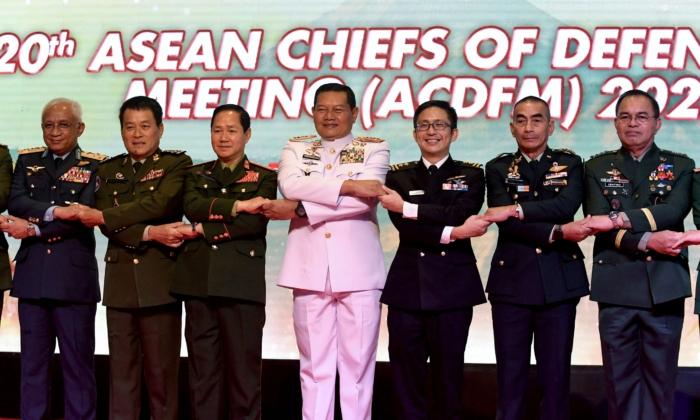The Kenyan government on Nov. 6 unilaterally released three documents from a loan contract with the Chinese communist regime for the country’s massive China-funded railway project. The documents stipulate that Kenya cannot disclose the contents of the contract to any third party without the consent of the financier, the Chinese bank. The Kenyan government’s disclosure has therefore attracted considerable attention.
The contract, for the construction of the standard-gauge railway (SGR), was signed in 2014 by then Kenyan President Uhuru Muigai Kenyatta and Chinese Premier Li Keqiang. Ever since, many in Kenya have questioned issues such as corruption, high debt, unemployment, and project failure risk, which lead to the new Kenyan President William Ruto releasing the documents from the contract to fulfill his election promise.
Analysts say it a rare move and express concerns that this could strain the Kenya-China relations.
The documents show the one-sided face of the contents are in China’s favor.
The Chinese side explicitly demanded that any goods bought using proceeds from the railway would preferably be sourced from China.
Any disputes arising from the execution of the agreement must be resolved through a Chinese arbitration committee.
Any default by Kenya on any other external loan would automatically result in a default clause on the rail loan, forcing Kenya to immediately repay the rail loan with full interest and giving the Chinese side the right to stop further funding.
Economist Tony Vatima said the loan’s terms were costlier than expected, as the interest rates on the loans are higher than usual for such deals between the two governments, according to the New York Times.
Corruption Leading to Project Failure
In the years between the signing of the contract for the SGR project and the Aug. 9, 2022 general election in Kenya, the project has been targeted in corruption investigations, there have been persistent protests by environmentalists over the destruction of the ecology of Kenya’s national parks and by the trucking industry over the massive unemployment that has led to hardship and social unrest.After completion of the 480 km (298 miles) of the Mombasa-Nairobi SGR, the original plan was to connect Kenya with Uganda by extending the line from Nairobi to Malaba, Kenya’s western border. However, the Nairobi-Malaba SGR ended abruptly in the wilderness of the East African Rift Valley. Beijing then withheld the $4.7 billion loan required to finish the project, leaving Kenya with an unfinished, unprofitable, railway and a huge debt to deal with.
On June 21, 2020, three judges at the Kenyan Court of Appeal ruled that the SGR project tender system ignored legitimate procurement procedures and that Kenya Railways Corporation (KRC), as the procurer, had violated the constitution. The court required KRC to disclose its agreement with the Chinese communist regime.
Before the Kenyan election, then-Vice President Ruto, 55, and then-Prime Minister Raila Odinga, 77, blamed each other for the SGR project and tried to draw a line from it, with Ruto admitting that the railroad had so far failed to boost the economy and Kenya became a victim because it had to repay its debt to China.
“The standard gauge railway is the jewel in the crown of corruption in Kenya,” John Githongo, a Kenyan high-ranking official who has spent a lifetime fighting corruption, said. “That’s a sad legacy of the current regime.”
A Replay of CCP-Aided Tanzania-Zambia Railway
The Kenya SGR project is reminiscent of the Tanzania-Zambia Railway, which was built with the help of the Chinese Communist Party (CCP) in the 1960s at great expense to the Chinese people.According to former Tanzanian Commerce Minister Abdulrahman Mohamed Babu, on Feb. 18, 1965, then Tanzanian President Julius Nyerere visited Beijing and formally proposed to then Chinese Chairman Liu Shaoqi, Premier Zhou Enlai, and Foreign Minister Chen Yi that he hoped China would assist in the construction of the Tanzanian Railway.
Then Zambian President Kenneth David Kaunda, who led his country to independence, was skeptical of communism, but was forced to agree with the CCP’s support for the construction of Tanzania-Zambia Railway, after failing to get assistance for infrastructure from the West.
On Sept. 5, 1967, during China’s Cultural Revolution, Zhou Enlai met with a joint Tanzanian-Zambian economic delegation and signed an agreement to support the construction of the Tanzanian-Zambian railroad.
In his book “Diplomatic Career in Extraordinary Times,” Zhou Boping, the then Chargé d'affaires of the Chinese Embassy in Tanzania, disclosed that “the total cost of the project was 1.09 billion yuan (about $152.7 million), all of which was provided by China. The original estimate of 988.37 million yuan (about $138 million) was a 30-year interest-free loan, and the overrun of 106 million yuan (about $14.8 million) due to the inflation was a free gift.”
In 1970, the construction work began on Oct. 26 in Tanzania and on Oct. 28 in Zambia.
China dispatched 56,000 engineering personnel. Over six years, 47 Chinese experts, technicians, and workers lost their lives on the job.
The 1,860.5-km (1,156-mile) long railway was finally completed on July 14, 1976.
The CCP reaped the benefits from the railway project in 1971, when the United Nations General Assembly Resolution 2758 was voted on. The Tanzanian delegates even wore Chinese uniforms to the vote. With the vast majority of African countries voting in favor, the Chinese communist regime replaced the Republic of China (Taiwan) in the UN.
A September 2009 article by Chinese state media Southern Weekly described the Tanzania-Zambia Railway as “an intangible asset” of the CCP’s diplomacy, and served as a “model and epitome” of the CCP’s foreign expansion in the early years of its rule.
The Tanzania-Zambia Railway was a major attempt by the CCP to break the Western blockade and to win over third-world countries in the early years. Today, its “Belt and Road Initiative” and “Community of Common Destiny” approach, is a continuation of its control over African countries.





